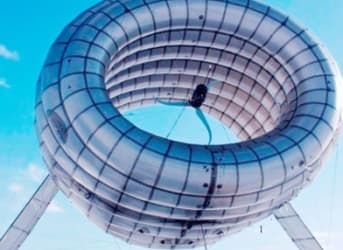A few months ago, and without much fanfare, Fairbanks, Alaska hoisted a large, oval, 35-foot diameter wind turbine to an altitude of 1,000 feet over the town. From high above, the BAT (Buoyant Air Turbine) generates power from gusts of wind far stronger than those powering regular wind turbines.
So how is the first airborne wind turbine to be deployed doing compared to the more familiar ground-based turbines?
A 1-megawatt (1MW) turbine on the ground generates on average between 2.4 million and 4 million kilowatt hours (kWh) of energy a year, which is enough to power between 240 and 400 houses. The BAT -- although it catches winds of up to eight times the force of ground turbines – has so far only generated enough power to meet the needs of about a dozen homes.
Altaeros, a start-up company created in 2010 at the Massachusetts Institute of Technology, designed the BAT, which consists of a helium-filled shell made from industrial fabrics. It conveys electricity to the ground through its tethers and is operated from ground stations made out of converted shipping containers.
Altaeros’ CEO Ben Glass says the BAT eliminates many of the traditional requirements of wind turbines, such as the need for cranes and towers to lift them hundreds of feet off the ground: automated tethers allow the BAT to rise and fall. Altaeros also claims BATs are quieter and easier to maintain, and cost 90 percent less to install than traditional wind turbines.
Although the BAT can’t match the output of organized wind farms directly tied into the electric grid, it -- and similar airborne wind turbine systems being developed by Google’s Makani Power, Germany’s Enerkite and Canada’s LTA Windpower -- is important because it can do what conventional turbines cannot: provide energy to remote sites that are off the grid.
The 12 households being powered in Fairbanks are not hooked up to the state’s electrical grid, and in a state that pays 17.57 cents per kWh of energy, compared to the U.S. average of 13.4 cents, that makes the BAT an attractive option.
And that group of households isn’t even a good measure of the BAT’s potential. Prior to its deployment in Alaska, the BAT was tested above the skies of Maine and was able to draw twice as much power as a conventional turbine. This could be achieved at an altitude of 1,000 feet – half the original estimation of 2,000 feet -- which means the BAT performs well far below most air traffic.
Makani Power is also looking beyond the possibility of static turbines -- both on the ground and in the air. It has developed a turbine that looks like a plane and mimics the wingtip of a wind turbine as it flies. Tethered to the ground, the Makani Turbine, now being developed in the secretive Google X laboratory, flies in a flat vertical loop. The craft, with a diameter of 24 feet, flies between 120 and 300 feet in the air, generating amounts of energy with its repeated looping flight that far outpaces the capacity of a normal turbine.
The company says the small Makani Turbine eliminates “90 percent of the materials and 50 percent of the installed costs of conventional wind turbines,” adding, “The tether allows our turbine to access better wind at high altitudes, which makes it cheaper to install in places where traditional turbines don’t work.”
And that’s the real benefit of airborne wind turbines: Rather than competing with established wind farms, they can be deployed in off-grid areas, such as island and remote communities, off-shore sites, mining sites, and even where disasters have occurred.
Expectations are that it will be a few years before Caribbean islands, remote Mongolian villages, or mines in the Australian outback have BATs or Makani Turbines soaring above them. But with a powerhouse like Google on the case, it may happen sooner than later.
By. Chris Dalby of Oilprice.com


















